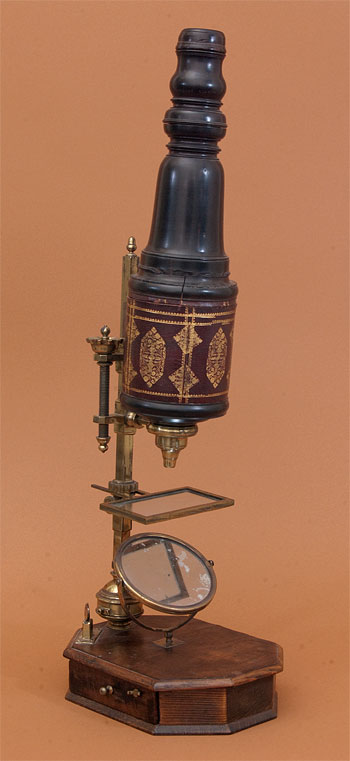 |
|||||
 |
 |
||||
 |
|||||
 |
 |
||||


Marshall microscopes had several advances over existing microscopes of the era. This instrument in the Golub Collection exemplifies many of those advances: a rigid support pillar; the stage supported on the same pillar; ball-and-socket joint at the base of the support; Hevelius screw focus; base-mounted condensing lens for transparent objects; a graduated set of objectives. All of these advances added to a highly prized instrument. There are only 17 or so known Marshall Great Double instruments in existence, and the Golub Collection is fortunate to have one. Interestingly, this instrument was modified by Edmund Culpeper well after John Marshall made it, and possibly after Marshall died.
The microscope has a main body made of cardboard and covered is gold-tooled leather. The polished brass objective nosepiece is screwed to a Lignum vitae base, that itself is glued to the cardboard body. The top half of the instrument consists of a cardboard draw tube covered in green vellum. It is topped with an elaborately turned wooden tube containing two biconvex lenses. In Marshall's original instrument this piece contained only the eyelens. The additional lens, possibly added by Culpeper (his name is embossed on the eyetube), has been added to the extended wooden top piece. The entire microscope is supported by a large brass pillar, which is hinged at the base by a large ball and socket (to allow the instrument to be tilted). The top of the pillar is decorated with an acorn. The glass stage is mounted to the same pillar, and is supported by two fingers that can be secured to a sliding support collar. The stage can be moved independently from the microscope body. Focusing was accomplished using a Hevelius screw mechanism fixed to the pillar with a jam screw. On the weighted, wooden base there is a brass mount that supported a condensing lens for transparent samples. (Missing in this instrument). Originally, Marshall did not outfit his microscopes with a mirror. The mirror on this instrument possibly was added by Edmund Culpeper.
Featured 11/2010